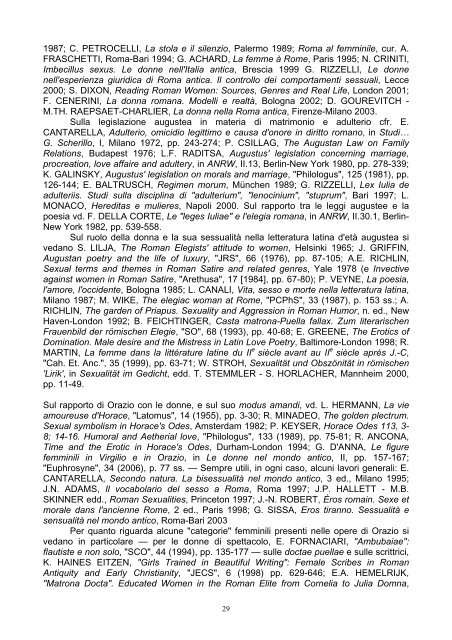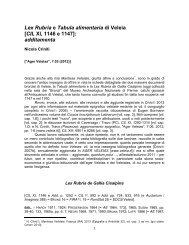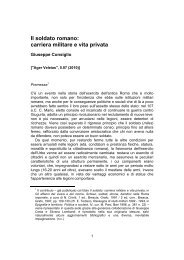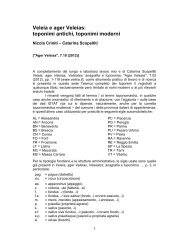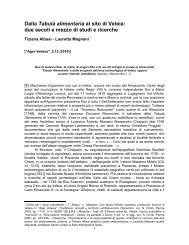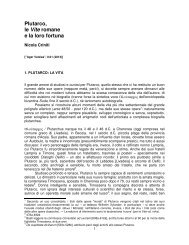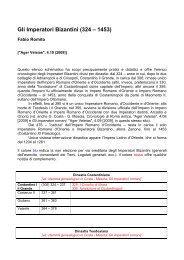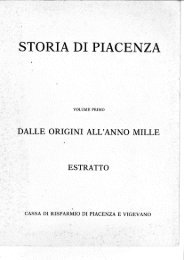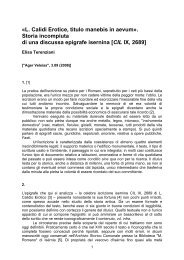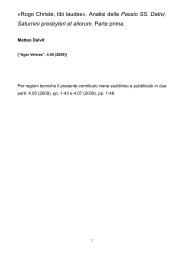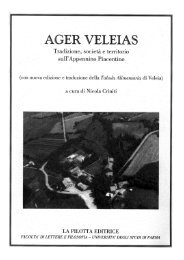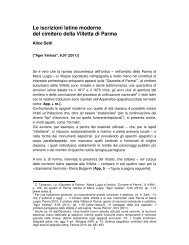Donne, liberti e schiavi nella Roma di Orazio - ager veleias
Donne, liberti e schiavi nella Roma di Orazio - ager veleias
Donne, liberti e schiavi nella Roma di Orazio - ager veleias
You also want an ePaper? Increase the reach of your titles
YUMPU automatically turns print PDFs into web optimized ePapers that Google loves.
1987; C. PETROCELLI, La stola e il silenzio, Palermo 1989; <strong>Roma</strong> al femminile, cur. A.<br />
FRASCHETTI, <strong>Roma</strong>-Bari 1994; G. ACHARD, La femme à Rome, Paris 1995; N. CRINITI,<br />
Imbecillus sexus. Le donne nell'Italia antica, Brescia 1999 G. RIZZELLI, Le donne<br />
nell'esperienza giuri<strong>di</strong>ca <strong>di</strong> <strong>Roma</strong> antica. Il controllo dei comportamenti sessuali, Lecce<br />
2000; S. DIXON, Rea<strong>di</strong>ng <strong>Roma</strong>n Women: Sources, Genres and Real Life, London 2001;<br />
F. CENERINI, La donna romana. Modelli e realtà, Bologna 2002; D. GOUREVITCH -<br />
M.TH. RAEPSAET-CHARLIER, La donna <strong>nella</strong> <strong>Roma</strong> antica, Firenze-Milano 2003.<br />
Sulla legislazione augustea in materia <strong>di</strong> matrimonio e adulterio cfr. E.<br />
CANTARELLA, Adulterio, omici<strong>di</strong>o legittimo e causa d'onore in <strong>di</strong>ritto romano, in Stu<strong>di</strong>…<br />
G. Scherillo, I, Milano 1972, pp. 243-274; P. CSILLAG, The Augustan Law on Family<br />
Relations, Budapest 1976; L.F. RADITSA, Augustus' legislation concerning marriage,<br />
procreation, love affaire and adultery, in ANRW, II.13, Berlin-New York 1980, pp. 278-339;<br />
K. GALINSKY, Augustus' legislation on morals and marriage, "Philologus", 125 (1981), pp.<br />
126-144; E. BALTRUSCH, Regimen morum, München 1989; G. RIZZELLI, Lex Iulia de<br />
adulteriis. Stu<strong>di</strong> sulla <strong>di</strong>sciplina <strong>di</strong> "adulterium", "lenocinium", "stuprum", Bari 1997; L.<br />
MONACO, Here<strong>di</strong>tas e mulieres, Napoli 2000. Sul rapporto tra le leggi augustee e la<br />
poesia vd. F. DELLA CORTE, Le "leges Iuliae" e l'elegia romana, in ANRW, II.30.1, Berlin-<br />
New York 1982, pp. 539-558.<br />
Sul ruolo della donna e la sua sessualità <strong>nella</strong> letteratura latina d'età augustea si<br />
vedano S. LILJA, The <strong>Roma</strong>n Elegists' attitude to women, Helsinki 1965; J. GRIFFIN,<br />
Augustan poetry and the life of luxury, "JRS", 66 (1976), pp. 87-105; A.E. RICHLIN,<br />
Sexual terms and themes in <strong>Roma</strong>n Satire and related genres, Yale 1978 (e Invective<br />
against women in <strong>Roma</strong>n Satire, "Arethusa", 17 [1984], pp. 67-80); P. VEYNE, La poesia,<br />
l'amore, l'occidente, Bologna 1985; L. CANALI, Vita, sesso e morte <strong>nella</strong> letteratura latina,<br />
Milano 1987; M. WIKE, The elegiac woman at Rome, "PCPhS", 33 (1987), p. 153 ss.; A.<br />
RICHLIN, The garden of Priapus. Sexuality and Aggression in <strong>Roma</strong>n Humor, n. ed., New<br />
Haven-London 1992; B. FEICHTINGER, Casta matrona-Puella fallax. Zum literarischen<br />
Frauenbild der römischen Elegie, "SO", 68 (1993), pp. 40-68; E. GREENE, The Erotics of<br />
Domination. Male desire and the Mistress in Latin Love Poetry, Baltimore-London 1998; R.<br />
MARTIN, La femme dans la littérature latine du II e siècle avant au II e siècle aprés J.-C,<br />
"Cah. Et. Anc.", 35 (1999), pp. 63-71; W. STROH, Sexualität und Obszönität in römischen<br />
'Lirik', in Sexualität im Ge<strong>di</strong>cht, edd. T. STEMMLER - S. HORLACHER, Mannheim 2000,<br />
pp. 11-49.<br />
Sul rapporto <strong>di</strong> <strong>Orazio</strong> con le donne, e sul suo modus aman<strong>di</strong>, vd. L. HERMANN, La vie<br />
amoureuse d'Horace, "Latomus", 14 (1955), pp. 3-30; R. MINADEO, The golden plectrum.<br />
Sexual symbolism in Horace's Odes, Amsterdam 1982; P. KEYSER, Horace Odes 113, 3-<br />
8; 14-16. Humoral and Aetherial love, "Philologus", 133 (1989), pp. 75-81; R. ANCONA,<br />
Time and the Erotic in Horace's Odes, Durham-London 1994; G. D'ANNA, Le figure<br />
femminili in Virgilio e in <strong>Orazio</strong>, in Le donne nel mondo antico, II, pp. 157-167;<br />
"Euphrosyne", 34 (2006), p. 77 ss. — Sempre utili, in ogni caso, alcuni lavori generali: E.<br />
CANTARELLA, Secondo natura. La bisessualità nel mondo antico, 3 ed., Milano 1995;<br />
J.N. ADAMS, Il vocabolario del sesso a <strong>Roma</strong>, <strong>Roma</strong> 1997; J.P. HALLETT - M.B.<br />
SKINNER edd., <strong>Roma</strong>n Sexualities, Princeton 1997; J.-N. ROBERT, Éros romain. Sexe et<br />
morale dans l'ancienne Rome, 2 ed., Paris 1998; G. SISSA, Eros tiranno. Sessualità e<br />
sensualità nel mondo antico, <strong>Roma</strong>-Bari 2003<br />
Per quanto riguarda alcune "categorie" femminili presenti nelle opere <strong>di</strong> <strong>Orazio</strong> si<br />
vedano in particolare — per le donne <strong>di</strong> spettacolo, E. FORNACIARI, "Ambubaiae":<br />
flautiste e non solo, "SCO", 44 (1994), pp. 135-177 — sulle doctae puellae e sulle scrittrici,<br />
K. HAINES EITZEN, "Girls Trained in Beautiful Writing": Female Scribes in <strong>Roma</strong>n<br />
Antiquity and Early Christianity, "JECS", 6 (1998) pp. 629-646; E.A. HEMELRIJK,<br />
"Matrona Docta". Educated Women in the <strong>Roma</strong>n Elite from Cornelia to Julia Domna,<br />
29


